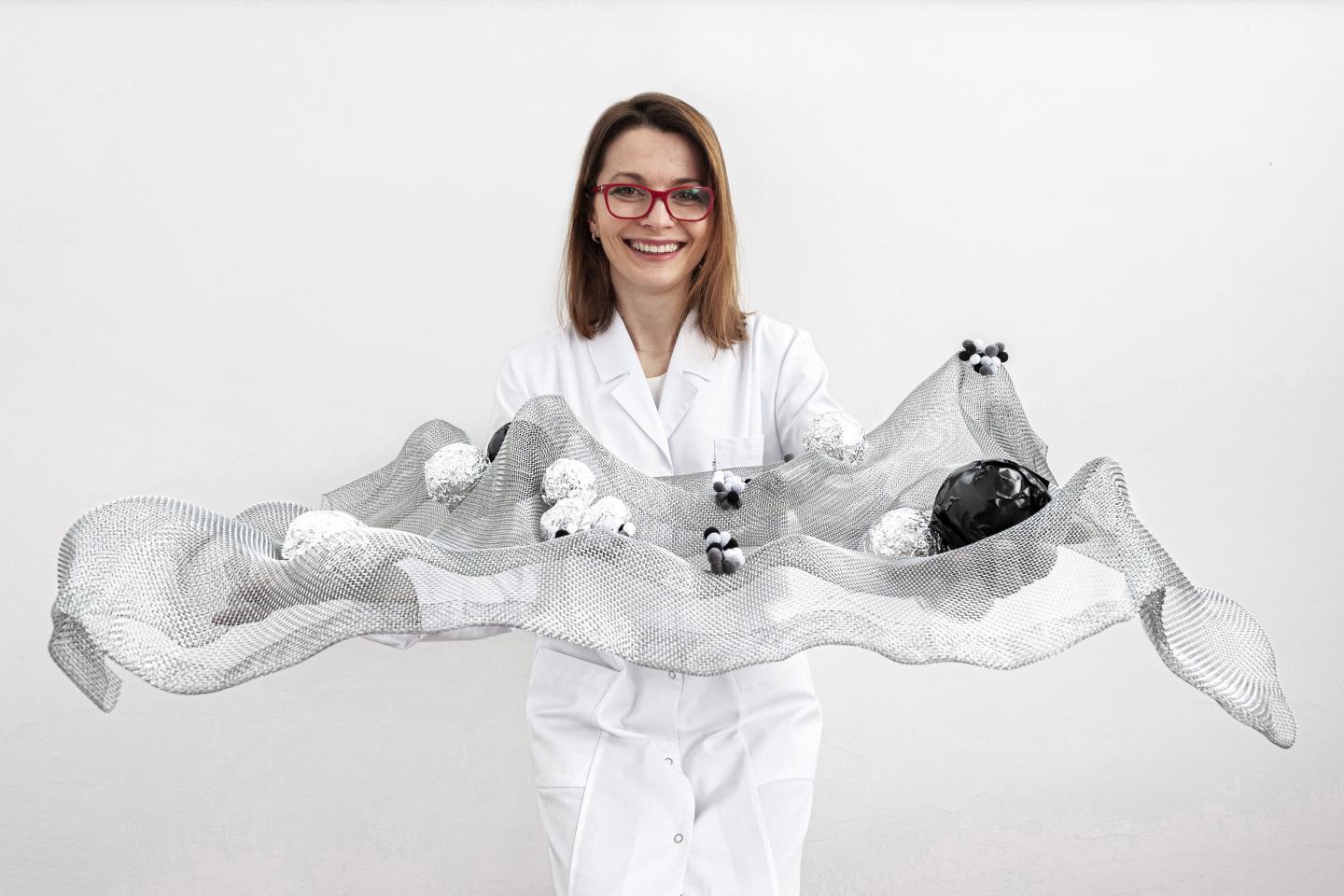
Credit: Source: IPC PAS, Grzegorz Krzyzewski
Solid-matrix catalysts called heterogeneous catalysts are among the most widespread industrial applications in reducing toxic gases, unburned fuel, and particulate matter in the exhaust stream from the combustion chamber. They are also used in energy, chemical, and pharmaceutical sectors, i.e., production of biodiesel, polymers, biomass/waste conversion into valuable products, and many others processes. All thanks to their active sites and high surface. Nevertheless, their high efficiency is limited by the astronomic price of noble metals, So, cost-effective substitutes with comparable effectivity seem to be a holy grail for the industry. A recent paper presented by scientists from the Institute of Physical Chemistry, Polish Academy of Sciences led by dr. eng.I zabela S. Pieta faces the challenge of presenting novel nanostructural bimetallic composite for catalysis.
C like catalysis
Catalysts are everywhere and have a tremendous impact on chemical processes. They surround us even in nature; for example, cells require natural catalysts like enzymes for multiple biochemical processes. The same happens in the energy conversion field, where solid catalysts pursue technological processes. According to the combustion engines, noble metals like platinum are placed on the flue gases flowing out the combustion chamber. Once toxic gases touch catalysts’ surface, they decompose, giving the final products CO2 and H2O. The secret lies in the active sites onto the material that influences the intermediates’ adsorption energy of reaction and transition states’ activation. The final mechanism of bond-breaking leads to the formation of particular molecules. It makes noble metals rock stars in industrial applications.
In recent decades, catalysts application tremendously grew, reaching a critical point for high costs of precious metals needed for fuel, pharmaceutics, and chemical compounds production. So, economic catalysis having high efficiency became one of the principal challenges for future progress in many industrial technologies. For sure, it is almost impossible to provide one material to fulfill all industrial requirements. We can surely improve much catalyst activity and even durability by chemical modifications of active surfaces for the given process, while let’s start from the beginning – catalyst size. Nanomaterials offer a high surface-volume ratio that increases their activity. In the case of noble metals, maintaining nanometric size makes these materials highly active, providing strong reactants binding and catalysts selectivity.
Novel catalysts on the horizon
Recently, scientists from the Institute of Physical Chemistry led by dr. Izabela S. Pieta described nanostructural bimetallic catalysts immobilized onto the semi-conducting surface for their potential application in the thermal-, photo-, and electrocatalysis. Those systems have already been reported to give extraordinary results in processes dedicated to fuel cells, i.e., methanol and ethanol electrooxidation (I.S.Pieta et al. Applied Catalysis B: Environmental, 2019, 244), sustainable green chemicals, and fuels production (I.S.Pieta et al. Applied Catalysis B: Environmental, 2019, 244, and ACS Sustainable Chemistry and Engineering, 2020, 8(18), and even carbon dioxide reduction towards gaseous ad liquid fuels (I.S.Pieta et al. Advanced Materials Interfaces, 2021, 2001822). Let’s take a look closer at them.
In bimetallic nanostructures, two metals, e.g., Pt-Au, are joined, where the primary metal works as a host role, and the second is a guest. In other words, it is an alloy, while on a nanometric scale, the distribution of particular atoms in the particles has tremendous meaning.
Interestingly, bimetallic structures occur higher catalytic activity in comparison to monometallic counterparts. Their joining may differ from a mixture of two different metals where the second one is distributed quite regularly in the matrix of the first one or core-shell structure where the first metal is covered with the second one. Another option is nanostructures having two chemically different halves (called Janus nanoparticles) or linking two chemically different nanoparticles. Unfortunately, these combinations of two different metals can undergo constant changes on such a small scale due to the atomic reorganization.
The composition and atomic arrangement in bimetallic structures determine their catalytic performance. Nanomaterials may easily agglomerate or change surface structure due to their high surface activity, lowering their catalysis effectiveness. Moreover, their surface can be easily poisoned by the half-products of chemical reactions, so predicting the changes taking place onto bimetallic surfaces affecting material activity is difficult.
So why don’t to start from the beginning and create a platform that would stabilize these nanostructures? Once settled, nanoparticles would be less susceptible to surface changes. Researchers proposed to stabilize bimetallic nanoparticles onto the electrically conducting material like carbon or carbon nitride. Then, its surface was modified with polymeric material based on the graphitic carbon nitride (g-C3N4) made of subunits of triazine molecules merged in flat triangles looking like the graphene sheet. The surface of the bimetallic system was investigated within several spectroscopic techniques.
“The development and optimization of bimetallic nanocatalysts might provide a new class of materials with superior, tunable performance, thermal stability, and reduced costs compared to presently available commercial catalysts. We anticipate that thanks to the unique properties of support material, i.e., graphitic carbon nitride, these catalysts can find a potential application in -thermal/-electro/ and -photocatalysis. However, before that happens, one needs to understand how to design the efficient bimetallic system, how this system works under operating conditions, and why the shape-structure-activity relation matters.” – Izabela S.Pieta claims. (GoGREEN project application H2020).
g-C3N4 has a rich heteroatoms structure that reveals catalytic properties. Thanks to the presence of multiple functional groups, it can easily host on its surface bimetallic systems like noble Pt-Au Pt-Pd, or transitions metals-based Cu-Ni nanoparticles. It has been considered as promising supporting material stabilizing the bimetallic nanoparticles and inhibiting their poisoning with chemicals. Moreover, it gives a huge opportunity for solar energy harvesting and conversion into a valuable product or another energy form.
“Inspired by nature, humankind has learned that sunlight is one of the most powerful sources of energy on the Earth. The effective conversion of light into a usable form of energy is mainly limited due to non-efficient charge separation and poor light-harvesting catalysts architecture. The prerequisites for broad spectral harvesting and favorable energy-level alignment for the intended light-triggered process should be coupled with fast charge separation and collection, competing successfully with photogenerated charge recombination. The issue mentioned above might be overcome by the proper selection of photoactive components and the suitable engineering of photoreactors. Combining the material properties and microfluidics technology is a perfect solution integrating multiple components and providing a simple solution for the continuous catalytic process at dynamic liquid-liquid, solid-liquid, or gas-solid-liquid interfaces’ – first author dr. Ewelina Kuna claims (the Pi of Pd2PI project holder).
Immobilization protects against surface changes and nanoparticle agglomeration and enables scalable application onto a large surface.
Remarks dr. Izabela Pieta – “The bimetallic catalytic systems are known to provide higher catalytic activities, and they allowed to reach very high efficiencies in many processes. We are still focused on more complex systems where the catalyst composition and structure arrangement may result in higher activity but higher selectivity towards targeted products and improved catalyst stability towards poisoning, durability, and lifetime. Our research covers a fundamental understanding of catalytic surfaces and reaction mechanism development under not-isolated conditions. This knowledge surely will result in innovative catalyst design, both at the molecular scale (active site architecture design) and applicative scale (industrial reactor-scale) via tailoring multiple catalytic active sites and their distribution over the working surfaces”.
Bimetallic nanoparticles embedded into the g-C3N4 modified carbon surface seems to be an universal platform in catalysis, bringing bright light into the processes that need novel nanostructural solutions. Thanks to such studies focused on the shape and structure-activity relation in bimetallic systems and its immobilization onto the scalable and economic matrix, we are a step closer to designs of the novel and sustainable catalysts for industrial.
###
Media Contact
Dr. eng. Izabela. S. Pieta
[email protected]
Related Journal Article
http://dx.





